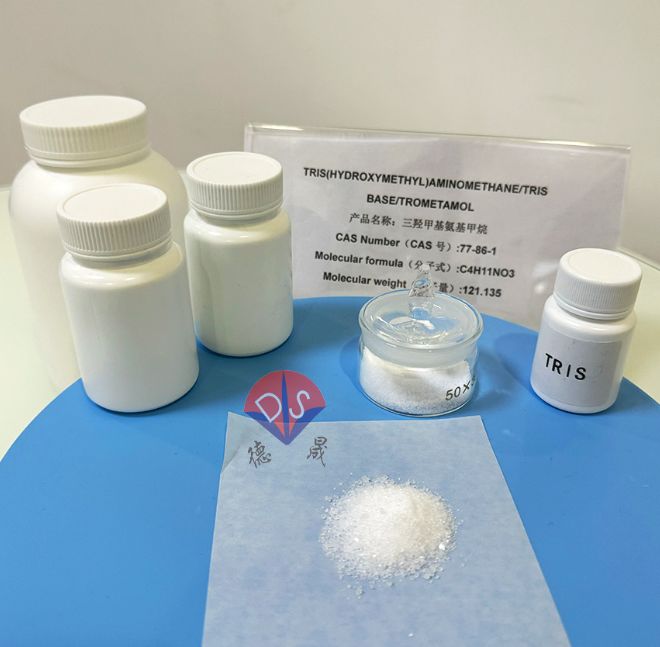What are the upstream raw materials for in vitro diagnostic reagents that have been ignited by downstream markets
Release time:
2025-07-12
In the vast chain of in vitro diagnostics (IVD) industry, the vigorous development of downstream market demand is effectively driving the upstream raw material field forward. The upstream raw materials of in vitro diagnostic reagents, as the cornerstone of the entire industry, have a wide variety of types, each of which plays an irreplaceable key role in the diagnostic process. With the expansion of downstream application scenarios and technological upgrades, some raw materials have ushered in unprecedented development opportunities.

(Biological buffer TRIS base)
1、 Antigen and antibody
In the field of immunodiagnosis, which occupies an important share of the IVD market, antigens and antibodies can be regarded as core raw materials. Antigens, whether they are prokaryotic/eukaryotic recombinant antigens prepared through genetic engineering recombination technology or antigens obtained through specific methods, are the key to preparing antigen based in vitro diagnostic reagents. The preparation process requires controlling multiple steps such as gene expression and protein purification to ensure the purity and activity of the antigen, in order to capture the target antibody in the diagnostic reagent and ensure the accuracy of the detection results.
Antibodies are equally indispensable, and monoclonal antibodies play a crucial role in cancer biomarker detection, autoimmune diagnosis, and other areas due to their high specificity; Polyclonal antibodies are widely used in some infectious disease screening due to their ability to recognize multiple antigenic epitopes. With the continuous improvement of downstream requirements for immune diagnostic sensitivity and specificity, the demand for high affinity and high-purity antigen antibody raw materials continues to rise.
2、 Diagnostic enzymes and coenzymes
Diagnostic enzymes and coenzymes play a catalytic role in biochemical diagnosis, molecular diagnosis, and some immune diagnosis. In biochemical diagnosis, various enzymes are used to detect indicators such as human metabolic products and enzyme activity. Enzyme reagents such as alanine aminotransferase (ALT) and aspartate aminotransferase (AST) are important raw materials for evaluating liver function. They catalyze specific chemical reactions to convert enzyme activity levels in the body into detectable signals. In the field of molecular diagnostics, reverse transcriptase, DNA polymerase, etc. are the core of PCR technology. The activity of these enzymes directly affects the efficiency and accuracy of nucleic acid amplification, and any performance fluctuations may lead to biased detection results. Coenzymes work together with enzymes to participate in and promote enzymatic reactions, ensuring the smooth progress of the diagnostic process. With the rapid and accurate development of downstream diagnostic technology, higher requirements have been put forward for the thermal stability, catalytic efficiency, and specific binding ability of diagnostic enzymes.
3、 Nucleic acid primers and probes
In the field of molecular diagnostics, nucleic acid primers and probes are key raw materials for achieving detection. Primer is a short single stranded nucleic acid sequence that binds to a specific region of template DNA during PCR amplification, providing a starting synthesis site for DNA polymerase and determining the specificity and length of the amplified fragment. A probe is a nucleic acid fragment with a label (such as a fluorescent group, radioactive isotope, etc.) that can specifically hybridize with the target nucleic acid sequence, and achieve qualitative or quantitative analysis of the target nucleic acid by detecting the label signal. In HPV typing testing, specific probes for different types of HPV viruses can accurately identify the corresponding viruses in the sample, providing a basis for clinical diagnosis. With the popularization of genetic testing technology in areas such as genetic disease screening and cancer gene diagnosis, the requirements for the accuracy, specificity, and stability of primer and probe design continue to increase, driving the development of related raw materials towards more refined directions.
4、 Buffer agents and bioactive materials
Although buffering agents and various bioactive materials do not directly participate in the core reaction of diagnosis, they are important for creating a stable and suitable reaction environment. Buffers, such as Tris, HEPES, etc., maintain the pH stability of the reaction system in in in vitro diagnostic reagents, ensuring that enzyme activity, antigen antibody binding, and other reactions occur under ideal conditions. In biochemical diagnostic reagents, a suitable buffer system can resist the acid-base changes generated during sample addition and reaction processes, ensuring the reproducibility of detection results. Bioactive materials, such as bovine serum albumin (BSA), are often used as blocking agents in immunodiagnostic reagents. They can block non-specific binding sites on the surface of carriers such as enzyme-linked immunosorbent assay (ELISA) plates and magnetic beads, reduce background interference, and improve detection specificity. Blockers, protectants, and other bioactive materials play an important role in protecting the activity of raw materials and preventing their degradation. With the increasing demand for stability and shelf life of diagnostic reagents downstream, optimizing the buffering capacity of buffering agents, purity and performance of bioactive materials has become an important direction for raw material research and development.

Product packaging
There are various types of upstream raw materials for in vitro diagnostic reagents, each of which plays a valuable role in different diagnostic techniques and application scenarios. Bioactive materials such as antigen antibodies, diagnostic enzymes, magnetic bead microspheres, nucleic acid primer probes, and buffering agents have attracted much attention due to the growing and refined demand in downstream markets for disease diagnosis and health screening.
Hubei Xindesheng Company, as an upstream raw material supplier, plays a key role in fields such as in vitro diagnostics. Its products cover multiple categories such as biological buffering agents, chemiluminescent reagents, and chromogenic substrates. Commonly used biological buffering agents such as Tris and Bicine, as well as new Trinder's reagents such as acridine ester chemiluminescent reagents and TOOS, can achieve a purity of over 99%. With advanced production technology and strict quality control system, Xindesheng ensures stable product quality and small differences between batches. Over the years, it has established cooperative relationships with numerous domestic and foreign enterprises to support the development of downstream industries. If you have any purchasing needs, please feel free to contact us at any time!
News
Contact details
Contact number
Address: C8, Guanggu United Science and Technology City, Ezhou City, Hubei Province
Fax:0711-3704 589
Follow us



